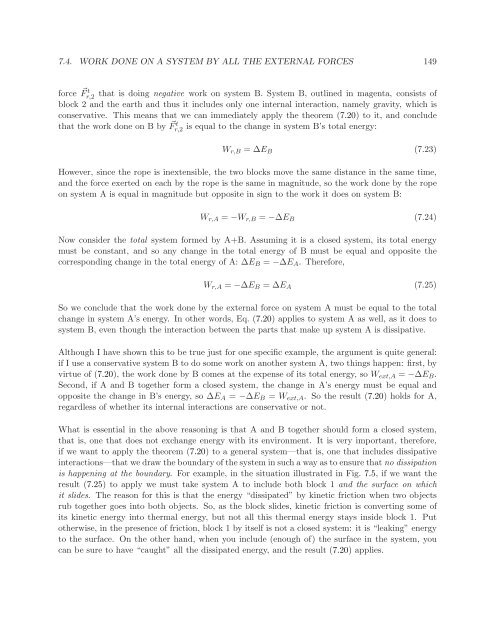University Physics I - Classical Mechanics, 2019
University Physics I - Classical Mechanics, 2019
University Physics I - Classical Mechanics, 2019
You also want an ePaper? Increase the reach of your titles
YUMPU automatically turns print PDFs into web optimized ePapers that Google loves.
7.4. WORK DONE ON A SYSTEM BY ALL THE EXTERNAL FORCES 149<br />
force F ⃗ r,2 t that is doing negative work on system B. System B, outlined in magenta, consists of<br />
block 2 and the earth and thus it includes only one internal interaction, namely gravity, which is<br />
conservative. This means that we can immediately apply the theorem (7.20) toit,andconclude<br />
that the work done on B by F ⃗ r,2 t is equal to the change in system B’s total energy:<br />
W r,B =ΔE B (7.23)<br />
However, since the rope is inextensible, the two blocks move the same distance in the same time,<br />
and the force exerted on each by the rope is the same in magnitude, so the work done by the rope<br />
on system A is equal in magnitude but opposite in sign to the work it does on system B:<br />
W r,A = −W r,B = −ΔE B (7.24)<br />
Now consider the total system formed by A+B. Assuming it is a closed system, its total energy<br />
must be constant, and so any change in the total energy of B must be equal and opposite the<br />
corresponding change in the total energy of A: ΔE B = −ΔE A . Therefore,<br />
W r,A = −ΔE B =ΔE A (7.25)<br />
So we conclude that the work done by the external force on system A must be equal to the total<br />
change in system A’s energy. In other words, Eq. (7.20) applies to system A as well, as it does to<br />
system B, even though the interaction between the parts that make up system A is dissipative.<br />
Although I have shown this to be true just for one specific example, the argument is quite general:<br />
if I use a conservative system B to do some work on another system A, two things happen: first, by<br />
virtue of (7.20), the work done by B comes at the expense of its total energy, so W ext,A = −ΔE B .<br />
Second, if A and B together form a closed system, the change in A’s energy must be equal and<br />
opposite the change in B’s energy, so ΔE A = −ΔE B = W ext,A . So the result (7.20) holdsforA,<br />
regardless of whether its internal interactions are conservative or not.<br />
What is essential in the above reasoning is that A and B together should form a closed system,<br />
that is, one that does not exchange energy with its environment. It is very important, therefore,<br />
if we want to apply the theorem (7.20) to a general system—that is, one that includes dissipative<br />
interactions—that we draw the boundary of the system in such a way as to ensure that no dissipation<br />
is happening at the boundary. For example, in the situation illustrated in Fig. 7.5, ifwewantthe<br />
result (7.25) to apply we must take system A to include both block 1 and the surface on which<br />
it slides. The reason for this is that the energy “dissipated” by kinetic friction when two objects<br />
rub together goes into both objects. So, as the block slides, kinetic friction is converting some of<br />
its kinetic energy into thermal energy, but not all this thermal energy stays inside block 1. Put<br />
otherwise, in the presence of friction, block 1 by itself is not a closed system: it is “leaking” energy<br />
to the surface. On the other hand, when you include (enough of) the surface in the system, you<br />
can be sure to have “caught” all the dissipated energy, and the result (7.20) applies.


















